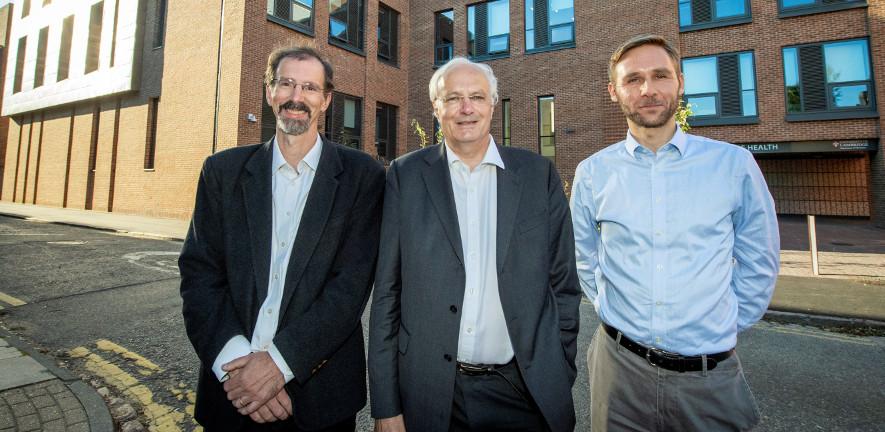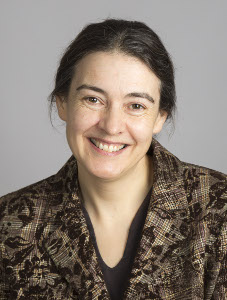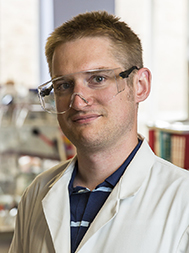
Dr James Keeler, Head of Department, says: "Congratulations to our colleagues who have been awarded prizes by the Royal Society of Chemistry. It is wonderful to see so many prestigious awards coming to the Department."
Professors Sir Christopher Dobson, Tuomas Knowles and Michele Vendruscolo (pictured together above) have won the Rita & John Cornforth Award for their groundbreaking collaborative interdisciplinary research on the molecular origins and treatment of neurodegenerative disorders.
Professor Clare Grey has been awarded the John B Goodenough Award for her pioneering and innovative uses of magnetic resonance methods to study structure and dynamics in electrochemical devices.
Professor Matthew Gaunt has won the Synthetic Organic Chemistry Award for his development of catalytic C-H activation strategies in aliphatic amines.
Dr Robert Phipps has received the Harrison-Meldola Memorial Prize for inventive research on the application of non-covalent catalysis to selectivity in synthetic organic chemistry.
In addition, a colleague from the Cavendish Laboratory - Dr Sam Stranks - has been awarded a prize by the Marlow Award 'for contributions to the development of hybrid perovskite semiconductor devices through fundamental understanding of the relationships between photophysical, chemical and material properties.'
Dr Robert Parker, chief executive of the Royal Society of Chemistry says: "Over the years, our lives have been significantly improved by the chemical sciences, from medicines and food to the environment itself. We are proud of the contribution the chemical sciences make to our global community, which is why it is right for us to recognise important innovations and expertise such as these.
"Our Prizes and Awards recognise people from a range of different specialisms, backgrounds and locations. Every winner is an inspiration to the chemistry community and will play an incredibly important role in enriching people’s lives for generations to come."
The awards to our colleagues in this department are:
Rita & John Cornforth Award
"We are absolutely delighted to have received this award from the Royal Society of Chemistry," said Sir Christopher. "This award is particularly important for us, as it recognises our long-term endeavour to establish a highly collaborative interdisciplinary programme to understand the molecular origins of protein misfolding disorders, and to develop methods to combat them."
As Co-Directors of the Centre for Misfolding Diseases, the team have developed and applied a range of advanced spectroscopic techniques to begin to define the mechanisms of protein aggregation and amyloid formation and to probe their consequences.
A particularly important breakthrough came with their development of a theoretical framework that enables experimental measurements of protein aggregation to be analysed by means of chemical kinetics, to reveal the rates of the individual highly coupled microscopic steps within the reaction network.
This development proved to be game-changing, and opened the way to a detailed structural and mechanistic understanding of the nature of the amyloid state of proteins and the ways they are formed. In addition, it allowed for the first time the analysis of the specific mechanisms by which the aggregation of proteins could be perturbed, thereby enabling the discovery of chemical compounds that can identify and block the generation of toxic intermediaries.
Since then a continuing series of advances, both experimental and theoretical, has lead to an increasingly profound understanding of the factors determining the molecular events underlying protein aggregation, and the manner in which they are linked to their effects on biological systems.
The results have enabled the establishment of rational strategies to identify molecules that can alter the rates of key steps in the aggregation process and in addition optimize their properties for potential therapeutic purposes.
John B Goodenough Award
 On receiving her award, Professor Grey said: "As a student at Oxford at the time when John was head of the Inorganic Chemistry Laboratory, I am particularly delighted to win the John Goodenough Award. His ground-breaking work, be it in battery electrode materials, in solid oxide fuel cell materials or in the development of the rules that describe magnetic couplings has inspired so much of my work."
On receiving her award, Professor Grey said: "As a student at Oxford at the time when John was head of the Inorganic Chemistry Laboratory, I am particularly delighted to win the John Goodenough Award. His ground-breaking work, be it in battery electrode materials, in solid oxide fuel cell materials or in the development of the rules that describe magnetic couplings has inspired so much of my work."
Longer lasting, higher-energy density, cheaper and safer rechargeable batteries are critically needed, especially to facilitate the shift from gasoline-powered to electric vehicles, and for storage and frequency regulation on the electricity grid. Professor Grey’s work has involved the development of new spectroscopic methods to determine the structures of the materials that are used in lithium, sodium and magnesium batteries. Specifically, she has developed methods which allowed her to determine local structure and oxidation state, and to probe mechanisms for electronic conductivity. She has directly measured how fast ions move in battery materials, helping to design higher power batteries that can be charged and discharged faster.
She has also developed new methods to study intact batteries under realistic operating conditions. For example, the research has shown how the finite ability of the radio frequency power can be used to separate bulk metallic vs. dendritic Li. Li dendrite formation can be quantified in situ in the battery, something that is extremely difficult to do by other methods. The formation of Li dendrites has been implicated in some recent battery safety issues, such as short circuits and battery fires.
Recent extensions of approaches to supercapacitors, devices that combine the high power capabilities of ceramic capacitors and the higher energy density of batteries – and that are now being used in mobile phones, and in transport world-wide – reveal that the in situ NMR method can be used to determine how the materials store charge, providing insight into how to optimise and increase the amount of energy that can be stored.
Synthetic Organic Chemistry Award

Professor Gaunt said: "I’m delighted that my team’s work on catalytic C–H activation of alkyl amines has been acknowledged through this award."
Methods that enable the selective functionalization of unreactive aliphatic C–H bonds have applications in fields that range from drug discovery to functional materials.
Over the past decade, chemists have tailored directing functional groups to enable C–H activation in a number of hydrocarbons via a process called cyclometallation. Palladium salts have been particularly successful at affecting catalytic C–H functionalization processes, but are often restricted to a single position with respect to the directing functional group.
"Our team questioned whether C–H activation could be controlled in molecules called alkylamines, a feature of molecules that are present in many pharmaceutical agents and other biologically important molecules. We identified a number of mechanistic factors that underpin the successful realization of our ideas, which led to the development of a series of new synthetic processes that enabled C–H activation in a wide range of alkylamines and streamlining the synthesis of complex variants of these molecules with previously unexplored properties. We expect that these methods will expedite the synthesis of new biologically active alkylamines which could aid the discovery of new medicines and agrochemicals," said Professor Gaunt.
Harrison-Meldola Memorial Prize

On receiving the award, Dr Phipps said: "It’s a real honour to be selected for the Harrison-Meldola Memorial Prize, particularly given the great achievements of the previous winners. It is certainly very gratifying to have this recognition for our group’s research. My students and co-workers have been instrumental to the group’s achievements over the last four years ,and I am eternally grateful to them for their efforts, trust and enthusiasm."
Dr Phipps is developing new ways to construct small organic molecules which can be used for a variety of purposes – from pharmaceuticals to biomolecules. His team's approach aims to develop catalysts that allow challenging reactions to occur while also allowing them to select which one of several possible products is ultimately obtained – a challenge referred to as selectivity.
Royal Society of Chemistry
The Royal Society of Chemistry’s Awards and Prizes are awarded in recognition of originality and impact of research, or for each winner’s contribution to the chemical sciences industry or education. They also acknowledge the importance of teamwork across the chemical sciences, as well as the abilities of individuals to develop successful collaborations.
Of those to have won a Royal Society of Chemistry Award, an illustrious list of 50 have gone on to win Nobel Prizes for their pioneering work, including 2016 Nobel laureates Jean-Pierre Sauvage, Fraser Stoddart and Ben Feringa.
Rewarding Excellence and Gaining Recognition
The Royal Society of Chemistry’s Prizes and Awards recognise achievements by individuals, teams and organisations in advancing the chemical sciences, and reward those undertaking excellent work in the chemical sciences from across the world. All prize winners will also receive a cash prize and a medal.
The Royal Society of Chemistry is an international organisation connecting chemical scientists with each other, with other scientists, and with society as a whole. Founded in 1841 and based in London, UK, it has an international membership of over 50,000. The surplus from its global publishing and knowledge business is used to support thousands of chemical scientists with the resources they need to make vital advances in chemical knowledge. The Society develops, recognises and celebrates professional capabilities, and brings people together to spark new ideas and new partnerships. It also supports teachers to inspire future generations of scientists, and speaks up to influence the people making decisions that affect us all.

